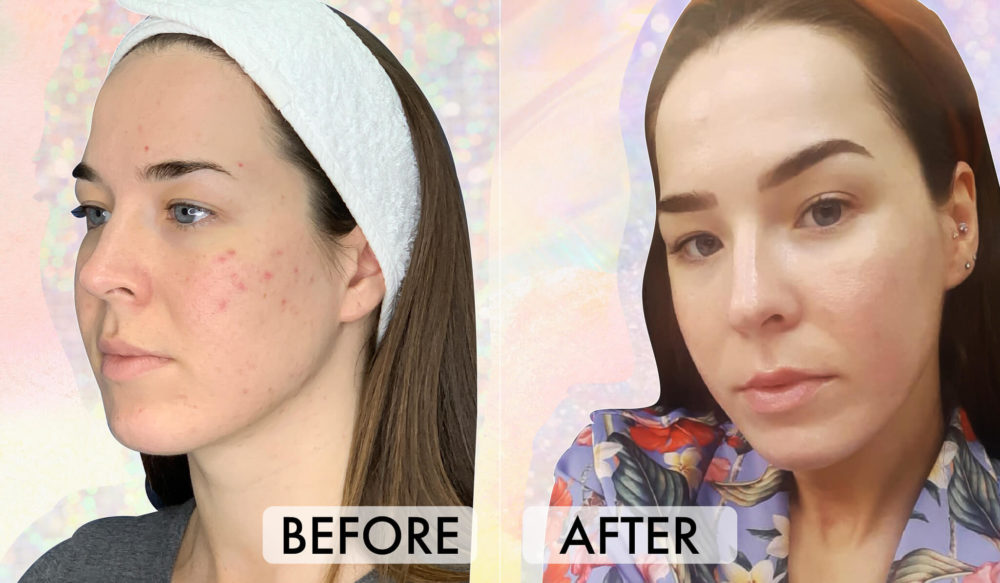Microcurrent Technology 101 – Does It Really Lift & Firm Skin?
 via Giphy
via Giphy
Microcurrent technology is a super buzzy skincare treatment these days – pun totally intended. In a nutshell, microcurrent devices stimulate the muscles under your skin, which in theory is supposed to create a lifted, chiseled, tightening effect. Sounds great, right? But do microcurrent treatments actually work, and if so what kind of results are we talking about here? We reached out to a couple skincare pros who weren’t shy about handing us the truth about both at-home microcurrent devices and in-office treatments.
What Is Microcurrent Technology?
Microcurrent devices are a type of non-invasive technology – meaning it doesn’t penetrate skin – that uses low-voltage electrical signals to stimulate your muscles.
The claim is that “microcurrents help lift and tone sagging facial muscles while also supporting collagen formation,” explains Dr. Audrey Kunin, a board-certified dermatologist. “They [are meant to] rejuvenate the face, creating a more youthful, rested and toned appearance.” Specifically they target fine lines, wrinkles, and saggy jowls.
There’s also some light research that suggests microcurrents can help with issues such as encouraging wound healing, decreasing inflammation, enhancing circulation, and boosting muscle function, notes Dr. Jodi LoGerfo, a Doctor of Nursing Practice (DNP) and Family Nurse Practitioner (FNP) certified in Family Medicine and Dermatology.
Do Microcurrent Devices & Treatments Really Work?
 via Giphy
via Giphy
Perhaps. Some people swear by microcurrent devices, while for others this technology elicits quite a bit of skeptical side-eye. The reality is that the microcurrents used in devices are generally pretty weak – particularly those approved for at-home usage, so any results truly will be subtle. Also, as it stands, “there is a [current] lack of evidence showing how effective, reliable, or safe their use is as a treatment for aging skin,” notes Dr. LoGerfo.
Posts You'll Love:
On the other hand, there’s surmounting anecdotal experiences and happy joyous praise for these microcurrent gadgets. In fact, some people say they wouldn’t dare skip their daily microcurrent buzz, arguing that it makes their skin look a bit firmer and glowier immediately after usage. Others also say that, when used long-term, they notice a difference in their overall skin quality, noting it’s more toned, taut, and smooth.
 via Giphy
via Giphy
Dr. Kunin is of the “it can work” camp. She says, “Home devices are helpful in minimizing the appearance of wrinkles and jowls and are especially good at extending results of in-office microcurrent treatments.” She also tells us that with the more robust in-office microcurrent treatments, you can see a noticeable difference between the treated half of the face and the non-treated side.
Dr. LoGerfo is a bit more skeptical, however. “I don’t generally recommend microcurrent treatments, but they theoretically could be used as part of an anti-aging regimen,” she tells us, implying that other treatments may give you more bang for your buck. She adds, “I think they could do more for maintaining your skin than actually treating a particular problem.”
Sooo basically? Your mileage may vary. There’s some light evidence of their benefits and anecdotal praise is far-reaching, but don’t expect a drastic result.
Are Microcurrent Skin Care Devices Safe?
 via Giphy
via Giphy
Yes, microcurrent devices are generally considered safe. A 2021 study stated that microcurrent treatments were “relatively safe” with relatively few side effects. That said, research is still underway by the scientific skincare community regarding long-term usage data.
“Microcurrents are probably not powerful enough to cause injury, so if used correctly, they should be OK,” Dr. LoGerfo notes. “There are, though, groups of people that should not use microcurrents, including those with heart disease, epilepsy, and those with implanted devices like a pacemaker or defibrillator. I would also not recommend microcurrent if you are pregnant.”
If using microcurrent technology at home, double check to make sure that the device is approved by the Food and Drug Administration (FDA). That information should be listed directly on the product labeling and/or website. And per usual, if you’re getting an in-office microcurrent treatment, it should be done by a licensed professional with a good reputation.
At-Home Microcurrent Devices to Try
Numerous at-home microcurrent devices are available, but these are our favorites. “When using an at-home treatment, microcurrents may need to be used more often to experience results because the currents are weaker,” says Dr. LoGerfo. If you want to incorporate a device into your regimen, aim for a five to 10 minute daily treatment. Along with a subtle lifting effect, the devices tend to create an instant, glow-y appearance.
- ZIPP Beauty OX Series, $480 (Here’s a first-person review if you want more deets.)
- NuFace TRINITY+ Starter Kit, $395
- Face Gym Pure Lift Face, $520
Consider yourself a skincare lover or just want to get more serious about your beauty routine? Create a lil’ at-home ritual that delivers major results with these eight inventive beauty tools.























Leave a comment